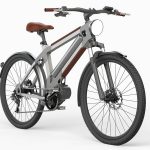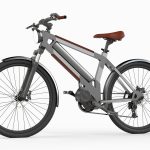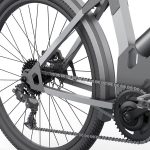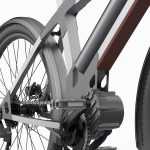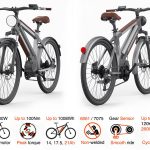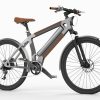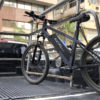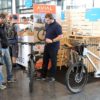The new generation of my mid-drive Hybrid Pedelec
19.11.2020
5092
The new generation of my Hybrid Pedelec is based on the latest prototype that I have ruthlessly tested in the city and off-road for 3000km (1800miles). This 250W mid-drive e-Bike has a non-welded frame the parts of which are connected together using rivets and special glue.
This e-Bike was designed as a bike that suits both city streets and cross-country. It combines the characteristics of different bicycles such as mountain e-bike, road e-bike, and city e-bike into a single unit. As a result, my Hybrid Pedelec is a general-purpose mid-drive e-bike capable of tolerating a gamut of riding conditions and applications. My own experience of regular trips around the city on weekdays and active out-of-town travel on weekends is an excellent confirmation of this.
Based on the results of recent studies carried out by scientists and engineers working for the aviation and auto industry, glue-riveted joints of units have sufficient strength and can withstand prolonged shock and vibration loads. In such a hybrid joint, rivets play the role of power points, and the glue layer redistributes the resulting stresses. Along with providing the specified strength properties, the glue-rivet joint provides the opportunity to combine elements from different alloys, which are difficult to weld. At the same time, the glue layer prevents galvanic corrosion between them.
My experience of self-assembly of the bicycle frame confirms that installing rivets using modern equipment is a technologically simple process. With modern equipment, it takes less time than to weld the frame from 6061 aluminum with subsequent heat treating of it to restore the T6 temper condition. Moreover, this method of making a frame does not require such professional training as an experienced welder needs. The MMA Structural Adhesive for use with the materials from which my frame is made was selected by the specialists of the manufacturer. The frame of my Hybrid Pedelec has gone through a CAD simulation cycle for glue-rivet conditions. My immediate plans are to create a working e-Bike prototype weighing up to 20 kg (44lbs) along with a battery for testing in various road conditions.
Changes that were made to the new generation of my Hybrid Pedelec compared to the last prototype:
(1) The used combination of 6061 and 7075 aluminum alloys allows to increase the strength of the frame and reduce the thickness of the elements used for its manufacture;
(2) The glue rivet joint provides vibration and load strength to the assembly of the entire structure, which makes it possible to optimize the number of rivets;
(3) The redesigned frame layout has reduced the wheelbase, which not only reduces the weight but also improves maneuverability;
(4) The frame has mounts that provide the possibility to mount commercially available rear fenders from various manufacturers. Front fenders can be mounted on standard suspension fork mounts;
(5) A prototype battery case with a capacity of 10.5Ah (378Wh) or 14Ah (504Wh) has been developed, which has additional cooling. This solution ensures even heat dissipation from the 18650 cells, which increases their lifespan.
Based on the test results of the working prototype, I plan to carry out a phased optimization of the frame and all its elements. The Hybrid Pedelec frame estimated weight of about 3.1kg (6.8lbs) is not the minimum achievable limit. There are developments of the bicycle frames made from aircraft-grade aluminum alloys without welding, such as the Ronin Bicycle with a frame weighing about 1.4kg (3.1lbs) – see https://avialbikes.com/news/in-ronin-bicycle-frame-using-sheet-metal-with-rivets-and-glue/) or 1.65kg (3.7lbs) TrixonLab Voiroo Bike frame – see https://avialbikes.com/news/the-frame-of-voiroo-zero-bicycle-fasten-on-rivets.
Baruch Dorfman
